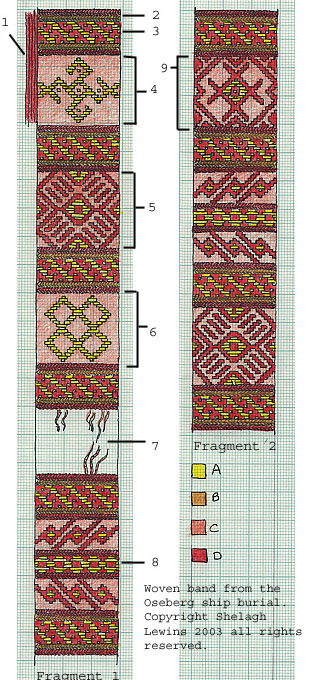
This document is provided as is without any express or implied warranties. While every effort has been taken to ensure the accuracy of the information contained, the author assumes no responsibility for errors or omissions, or for damages resulting from the use of the information contained herein.
Permission is granted to make and distribute verbatim copies of this document for non-commercial private research purposes provided the copyright notice and this permission notice are preserved on all copies. Website mirroring is permitted by express prior arrangement. Permission will only be granted if the document is posted in its entirety and the content and format of the document remain completely unaltered by the mirroring site. The definitive version of this document can be found at http://www.shelaghlewins.com.
Copyright © 2003 Shelagh Lewins.
One of the textile finds from the Oseberg ship burial is a brocaded band, which is on display in the Viking Ship Museum in Oslo. I looked at the band in May 2003, and this article summarises what I was able to learn about it.
The band is now a dull brownish red with pale motifs. However, a watercolour painting of the second fragment, dating from early in the 20th century, gives more clues as to the original colouring [1].
The band is about 1 inch wide, or perhaps a little wider. It is woven in fine wool, probably using a linen weft which is now perished. There seems to have originally been a plain border, also of wool. At least three different technique appear to have been used to weave the band:

Four colours are used on the diagram to represent different types of thread and weaving:
1. Border of wool, now detached from the band except at one point. Possibly it is the brocade weft which has held the border on here.
2. Surface decoration in two colours of wool. Either soumak (an additional thread wrapped around the warp threads) or embroidery has been used to create horizontal lines with a diagonal structure (see drawing below). Two rows of dark thread (colour D) are followed by two rows of light threads (colour B). These rows of soumak are repeated across the band as a standard border to pattern areas.

Detail of Soumak Decoration
3. Silk brocade applied over wool ground weave.
4 and 6. Silk brocade applied over wool ground weave. Although it cannot now be seen, I would think it likely that these areas were also weft-patterned to complement the brocade patterns, as in sections 5 and 9.
5 and 9. Warp-woven pattern in colours C and D, with additional motifs in yellow silk brocade. Although these motifs could have been woven using tablets, for example in a 3/1 broken twill, the surface of the band in these areas looks more like plain weave than tablet weave. However, I was not able to draw any firm conclusions about the underlying weave of the band or the technique by which the warp-woven patterns were created, due to the poor state of the band, and the fact that I could only see it through glass under low light.
7. Damaged section of band..
8. Silk brocade applied over wool ground weave. The pattern is flanked on either side by two rows of soumak wrapping in colour D, and then flanked again by patterns which combine warp-patterning and brocade weft, as in sections 5 and 9.
On studying the watercolour in the original book, rather than the small reproduction to which I first had access, I've updated the pattern analysis - see below. Some of the sections I thought were soumak look more like plain weave, and the main pattern areas look as though they are made of vertical floats. But until the full archeological report is published, this remains speculation.